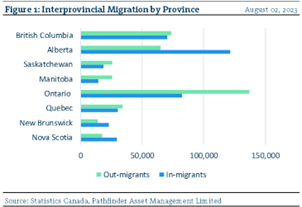Alberta Real Estate Insights
A couple of weeks ago, we had the opportunity to go on a tour to Calgary, where we met with management of 5 Canadian REITs in different sectors and toured a number of their properties. The sentiment was unanimously positive across all sectors of real estate, predominantly stemming from an increase in residential demand. Population growth is coming in all forms to Alberta, both as a destination for immigration into Canada, and more topically, with migration from other provinces. Figure 1 illustrates this in comparison to other provinces, whereby Alberta has the largest number of migrants coming from other provinces by a healthy margin (Statistics Canada).

We started to see a positive impact on real estate value stemming from the growth in residential demand. In Calgary specifically, the demand for residential properties is increasing in both the city center as well as the outer edges of the city. On the north end of the city, you can see the ample construction of houses and apartment complexes; however, as people migrate into the province, there is a supply lag due to building time, creating a supply-demand imbalance for residential properties that constantly increases. An example of this that we saw was a downtown apartment owned by one of the REITs. We viewed one of their vacant suites that received over 200 applicants shortly after being listed.
As can be expected, a larger population means more demand for retail from an increasing consumer base. We met with two retail REITs who both noted that Calgary shopping centers are among the highest performing in their portfolios, specifically the shopping centers anchored by large, well known grocery stores such as Loblaws or Walmart. The more notable finding was the ability for shopping center owners to capture the rise in residential demand as well. REITs owning large malls and shopping centers are now able to unlock the increase in value of this space by developing apartment buildings on excess, unused parking lots. This allows them to create a mixed-use space of apartment buildings adjacent to retailers, creating a convenient and attractive place of residence for future tenants.
“This means that” it remains critical for investors to understand what they own and why they own it. While real estate as an asset class has been experiencing a drawback due to the rise of interest rates, we see opportunity to find value with specific assets (for example, retail & residential in Alberta and industrial properties in Mexico) that have different growth prospects and fundamentals than the asset class as a whole. This is why we research the business at the company level, meet management and tour properties. This part of the investment process allows us to identify where we believe these outliers may be and then adjust our portfolios and funds to take advantage of our ever-evolving thesis.
National Instrument 31-103 requires registered firms to disclose information that a reasonable investor would expect to know, including any material conflicts with the firm or its representatives. Doug Johnson and/or Pathfinder Asset Management Limited are an insider of companies periodically mentioned in this report. Please visit www.paml.ca for full disclosures.
Changes in Leverage. We are increasing the asset ceiling to 2.0 times the market value of equity for Pathfinder International Fund and Pathfinder Real Fund to be consistent with Pathfinder Partners’ Fund and Pathfinder Resource Fund.
*All returns are time weighted and net of investment management fees. Returns from the Pathfinder Partners’ Fund and Partners’ Real Return Plus Fund are presented based on the masters series of each fund. The Pathfinder Core: Equity Portfolio and The Pathfinder Core: High Income Portfolio are live accounts. These are actual accounts owned by the Pathfinder Chairman (Equity) and client (High Income) which contain no legacy positions, cash flows or other Pathfinder investment mandates or products. Monthly inception dates for each fund and portfolio are as follows: Pathfinder Core: Equity Portfolio (January 2011), Pathfinder Core: High Income Portfolio (October 2012) Partners’ Fund (April 2011), Partners’ Real Return Plus Fund (April, 2013), and Partners’ Core Plus Fund (November 2014).
Pathfinder Asset Management Limited (PAML) and its affiliates may collectively beneficially own in excess of 10% of one or more classes of the issued and outstanding equity securities mentioned in this newsletter. This publication is intended only to convey information. It is not to be construed as an investment guide or as an offer or solicitation of an offer to buy or sell any of the securities mentioned in it. The author has taken all usual and reasonable precautions to determine that the information contained in this publication has been obtained from sources believed to be reliable and that the procedures used to summarize and analyze such information are based on approved practices and principles in the investment industry. However, the market forces underlying investment value are subject to sudden and dramatic changes and data availability varies from one moment to the next. Consequently, neither the author nor PAML can make any warranty as to the accuracy or completeness of information, analysis or views contained in this publication or their usefulness or suitability in any particular circumstance. You should not undertake any investment or portfolio assessment or other transaction on the basis of this publication, but should first consult your portfolio manager, who can assess all relevant particulars of any proposed investment or transaction. PAML and the author accept no liability of any kind whatsoever or any damages or losses incurred by you as a result of reliance upon or use of this publication.